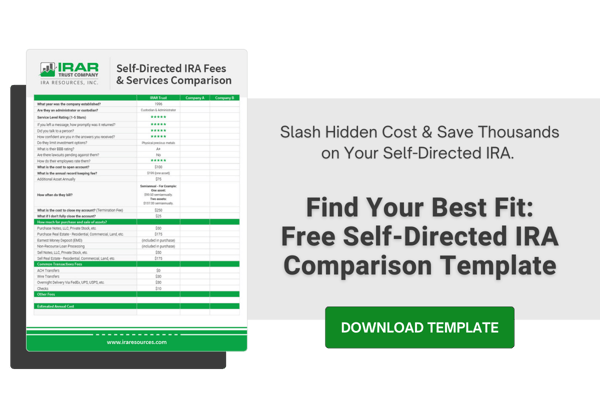7 Steps to Retire Rich With A Self-Directed IRA

“When I was just a little girl, I asked my mother what should I be? Will I be pretty, will I be rich, and this is what she said to me: open a self-directed IRA.”
Okay, so maybe she said “que sera, sera” (whatever will be, will be), because self-directed IRAs didn't come about until 1974 with the Employee Retirement Income Security Act (ERISA). Plus, not many people were aware of self-direct IRAs. In fact, there are many people that still don't know about these IRAs today. I wished I had learned about these sooner.
Ultimately, the opportunity to invest in a self-directed IRA for retirement could be yours. Here are 7 steps to get you on the pathway to financial freedom you'll wish your mother or financial professional had told you about sooner.
Step 1: Understanding a Self-directed IRA (SDIRA)
Through a self-directed IRA, account holders are free to choose from a range of alternative investment types and direct their savings. Like other IRA account types, self-directed IRAs are also tax-advantaged. Earnings grow tax-deferred or tax-free and will not be taxed until the account holder is eligible to make withdrawals when they turn 59 and a half. Beware that unless an exception is made, early withdrawals will lead to a 10% penalty fee.
Because of the risk involved, this account type is best suited for investors experienced in a particular alternative asset. The investor has to undertake the due diligence and ongoing management of the underlying assets involved. Investors will also need to open a self-directed individual retirement account and make investments through an IRA custodian or trust company.
Step 2: Understanding How a Self-directed IRA Compares to Other Retirement Accounts
Unlike your standard IRA or 401(k), which limits your range of choices to publicly traded assets like stocks, bonds, mutual funds, and ETFs, a self-directed IRA gives investors the opportunity to leverage a multitude of alternative investments to build wealth.
Self-directed IRA account holders are free to invest in their asset of choice at any time by simply requesting the purchase of the asset. However, you must work with a qualified self-directed IRA custodian to take advantage of this strategy.
Step 3: Do Your Research
You may be asking yourself, “can I retire rich with a self-directed IRA?" While there is no straightforward answer to that question, it is loaded with potential. Here’s a list of alternative investment types you may want to invest in through your self-directed IRA:
- Real estate
- Undeveloped or raw land
- Promissory notes
- Tax lien certificates
- Gold, silver, and other precious metals
- Cryptocurrency
- Water rights
- Mineral rights, oil, and gas
- LLC membership interest
- Private equity
- Livestock
As you can see, these markets can vary greatly. Some investors may already be involved in one of these industries and have insights into how to leverage a particular asset type.
REALTORS for instance are at an advantage to maximize their return on investment through a real estate IRA because they know the ins and outs of types of real estate and can manage their investment if that particular market experiences any turmoil. Suffice to say, do your research before settling on a specific alternative investment.
Note that some investment types, like collectibles and life insurance, are prohibited to invest through a self-directed IRA per IRS regulations. This is why knowing the rules and limitations when it comes to your self-directed IRA is crucial to your research process. Make sure to understand these rules so you do not engage in a prohibited transaction.
Step 4: Choosing Your Investment Strategy
“Don’t put all of your eggs in one basket.” Diversification of asset classes may strengthen your overall portfolio. As any seasoned investor knows, diversification can help reduce your portfolio’s risk so that one asset or asset class’s performance doesn’t affect your entire portfolio.
Step 5: Be Aware of Costs and Fees
Investors will want to be aware of the costs and fees associated with setting up and maintaining a self-directed IRA. Transaction fees should also be factored into the equation. Some fees may vary according to the type of investment made as well. Make sure that all fees related to the IRA include explanation if needed— don't guess.
Step 6: Open Your Self-Directed IRA Account
You can open a self-directed IRA account in as little as 10 minutes. Be sure to have your personal information, a Government-issued ID, and credit card handy. Then, choose the type of account for example, Roth IRA (post-tax contributions) or Traditional IRA (pre-tax contributions), and voila — you are on your way to financial freedom.
Small business owners can also take advantage of self-employed retirement accounts. If you are not sure what type of account is best for you, first consult with a financial advisor for investment advice.
Step 7: Choosing A Trustworthy Custodian for Your Account
For nearly 30 years, IRAR has empowered people to build wealth through alternative investments at a lower cost. Our mission is to help investors plan for a better, less expensive way to save for retirement. We do this by providing clients with a cost-effective solution that allows them to build retirement savings at affordable rates.
We believe your retirement funds should grow, not your annual fees. That’s why IRAR charges a flat annual fee per asset. This allows clients to save up to 50 percent compared to the competition.
Book a free consultation with one of our experts today to learn more about opening a self-directed IRA and the investment options available to plan for a richer retirement.










Comments (0)